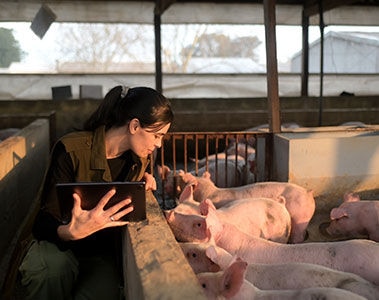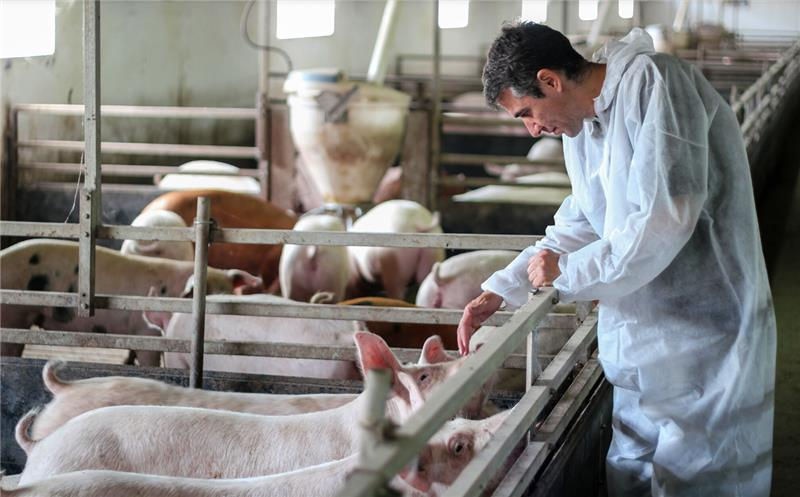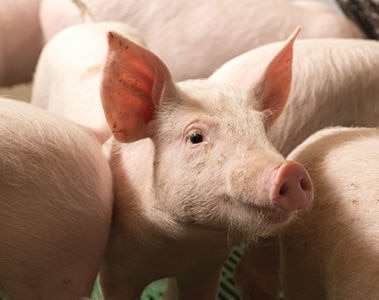All of these factors together mean that diet formulation during early life is critical to future production outcomes. Weaning diets need to be carefully formulated to ensure they contain highly digestible, low-antigen ingredients, with antinutrients effectively minimized or controlled.
Common antinutrients in piglet feed
The main antinutrients of concern in piglet feed are:
- Allergens from feed materials
- Mycotoxins
- Peptidoglycans
- Undigested nutrients – crude protein, phytate and viscous fibre
1. Allergens from feed materials – e.g. Soybean
The major allergenic proteins in soybean are glycinin and -conglycinin. As storage proteins, these are partially resistant to heat treatment and other processing technologies. In piglets, whose immune systems are not yet sufficiently developed to recognize them as harmless proteins, they cause hypersensitivity (inflammatory) reactions. This results in impaired gut homeostasis and functionality, and reduced nutrient absorption.
To reduce these effects, piglet diets are formulated with lower levels of soybean meal. Highly digestible protein sources are used in place of soybean meal, along with the addition of synthetic amino acids (AA) to ensure essential AA requirements are met.
2. Mycotoxins
Fungal-derived mycotoxins are common contaminants of feed that affect gut permeability and functioning. Whereas aflatoxin in feed is routinely monitored and levels tightly regulated worldwide, this is not the case for other mycotoxins. Fumonisin, deoxynivalenol (DON) and zearalenone (ZEN) are all common in feed in Asia and can have direct and synergistic effects on the expression and function of tight junction proteins in intestinal epithelial cells. This impairs gut barrier integrity, allows the ingress of more mycotoxins and facilitates pathogen invasion2,3.
Studies of DON have shown that it:
- Activates T lymphocytes in porcine epithelial cells leading to increased expression of inflammatory cytokines4. This inflammatory response is nutrient-demanding and redirects nutrients away from growth.
- Reduces porcine reproductive and respiratory syndrome (PRRS) vaccination efficacy by impairing the antibody response. This effect is seen at 2.5 to 3.5 mg of DON/kg5.
- Predisposes piglets to porcine epidemic diarrhoea virus (PEDV) which causes acute diarrhoea and impaired growth. This effect is seen at or above 750 mg DON/kg6.
In addition, in vitro studies have shown that aflatoxin B1 can negatively impact bone development by reducing expression of the vitamin D receptor and reducing uptake of Vitamin D in bone7.
3. Peptidoglycans
Peptidoglycans are a major component of bacterial cell walls. They contain lipoproteins that are recognized as foreign by piglet immune system. This causes an inflammatory response8 which is nutrient-demanding and therefore redirects nutrients away from growth. Peptidoglycans can also act as a physical barrier in the gut, directly reducing the absorption of nutrients which impacts on growth9.
4. Undigested nutrients
a. Crude protein
Soybeans and other legumes contain protease inhibitors—such as the Kunitz and Bowman-Birk types—that impair protein digestion by blocking enzymes like trypsin and chymotrypsin. This leads to more undigested protein in the gut, promoting proteolytic fermentation and the production of toxic nitrogenous metabolites (e.g., ammonia, amines), which contribute to diarrhoea and reduced feed efficiency. Over time, these effects can disrupt gut health and immune function. Heat treatment reduces inhibitor activity, but excessive heating should be avoided as it can impair energy and amino acid digestibility through Maillard reactions, particularly affecting lysine availability.
Formulating high-protein diets further increase undigested protein in the hindgut, reducing nitrogen retention efficiency. This effect is worsened under poor sanitary conditions, which amplify microbial fermentation, inflammation, and immune stress—diverting nutrients from growth (Myrthe Gilbert, unpublished data).
Finally, a high protein diet has recently been shown to downregulate anti-inflammatory cytokines (IL12B) and upregulate pro-inflammatory cytokines (CCL2, CXCL12 and CXCL9) in mesenteric lymph nodes10. This inflammatory response is partly driven by increased microbial activity associated with high-protein diets, leading to a greater load of bacterial debris—particularly peptidoglycans. Supplementation with muramidase in high-protein diets has been shown to reduce this pro-inflammatory response, as the enzyme breaks down immune-stimulating peptidoglycans, thereby lowering inflammation and supporting gut health and growth10.
b. Phytate
It is well known that phytate binds to minerals, proteins, AA and endogenous nutrients in the digesta, reducing their accessibility for digestion and absorption. This increases the endogenous flow of nutrients and reduces the ileal digestibility of nutrients and energy, both of which can lead to reduced growth performance.
Figure 3 illustrates the mechanisms of action of dietary phytate (salt of phytic acid ) on ileal digestibility and endogenous losses of nutrients. Its effect on phosphorus availability and digestibility is particularly important because phosphorus is a key driver of piglet performance and an essential nutrient for both gut microbes and the host.
Although phytate levels in piglet diets are lower than in older animals, their immature digestive systems make them more vulnerable to its effects. Supplementing with exogenous phytase improves phosphorus release and nutrient availability, supporting optimal growth and development.



